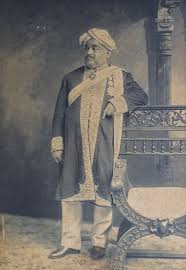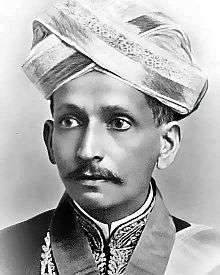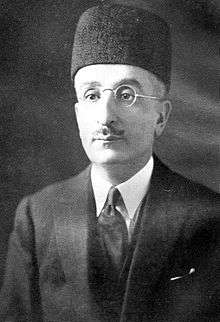List of Diwans of Mysore
The Maharajas of Mysore founded the kingdom in 1399 with a brief interruption in the last two decades of the 18th century. After Tipu Sultan, the concept of Diwans was conceived in the Kingdom, with Diwan Purnaiah as the first ever Prime Minister of the Kingdom of Mysore, who was a diwan for Tipu Sultan, and after the end of the Sultans, to the Maharaja of Mysore His Highness Krishnaraja Wadiyar III - the heroic king who restored the kingdom that was halved by Tipu Sultan losing most of its parts to the Nizam of Hyderabad, the Marathas, and the British in the Third Anglo-Mysore War. The word Dewan (in Urdu) means the Prime Minister of a kingdom; more precisely, a royal advisor to the monarch.
The following lists the Diwans of Kingdom of Mysore through 1799 to 1947. The most notable of the diwans are: Diwan Purnaiah, Diwan Sir C. V. Rungacharlu, Diwan Sir K. Seshadri Iyer, Diwan Sir P. N. Krishnamurti, Diwan V. P. Madhava Rao, Diwan T. Ananda Rao, Diwan Sir M. Visveswarayya, Diwan M. Kantaraj Urs, and Diwan Sir Mirza Ismail. Many of the diwans are associated with several industrial and educational initiatives undertaken during their terms. These initiatives include almost all works assigned/ directed by the king, permeating activities like setting up and maintaining industries like Hindustan Aeronautics Limited, Visvesvaraya Iron and Steel Plant, Mysore Lamps, Mysore Chemical and Fertilizers Factory, Mysore Paper Mills, Mysore Paints and Varnish Limited. The State Bank of Mysore was established in 1913. Dams for irrigation like Krishna Raja Sagara in 1924 and Hydroelectric Power Plants on Shivanasamudra Falls in 1902 and Jog Falls. Bangalore was the first city in India to get electric street lights in 1905.
| № | Name | Portrait | Took office | Left office | Term | Monarch |
|---|---|---|---|---|---|---|
| 1 | Purnaiah |  |
29 December 1782 | 4 May 1799 | 1 | 
(Began the culture of diwans in Mysore Kingdom) |
| 4 May 1799 | April 1811 | 
| ||||
| 2 | Bargir Bakshi Balaji Rao | April 1811 | January 1812 | 1 | ||
| 3 | Savar Bakshi Rama Rao | February 1812 | October 1817 | 1 | ||
| 4 | Babu Rao | November 1817 | April 1818 | 1 | ||
| 5 | Siddharaj Urs | May 1818 | February 1820 | 1 | ||
| (4) | Babu Rao | March 1820 | August 1821 | 2 | ||
| 6 | Lingaraj Urs | November 1821 | November 1822 | 1 | ||
| (4) | Babu Rao | December 1822 | November 1825 | 3 | ||
| Direct rule by Krishnaraja Wadiyar III | November 1825 | May 1827 | ||||
| 7 | Venkata Urs | May 1827 | October 1831 | 1 | ||
| 8 | Venkataramanaiya | October 1831 | 14 May 1832 | 1 | ||
| (4) | Babu Rao | May 1832 | 19 April 1834 | 4 | ||
| 9 | Kollam Venkata Rao | 20 April 1834 | 1838 | 1 | ||
| 10 | Surappaya | 1838 | 1840 | 1 | ||
| (9) | Kollam Venkata Rao | 1840 | 1844 | 2 | ||
| 11 | Kola Krishnama Naidu | 1844 | 1858 | 1 | ||
| 12 | Sir Kola Vijayarangam Naidu | 1858 | 1864 | 1 | ||
| 13 | Arunachala Mudaliar | 1864 | 1866 | 1 | ||
| Direct rule by Krishnaraja Wadiyar III | 1866 | 1868 | ||||
| Temporary rule of the British Raj | 1868 | 20 March 1881 | Subsidiary Alliance between the Kingdom of Mysore and the British East India Company | |||
| 14 | Sir C. V. Rungacharlu[1] |  |
25 March 1881 | 20 January 1883 | 1 | 
|
| 15 | Sir K. Seshadri Iyer |  |
21 January 1883 | 28 December 1894 | 1 | |
| 28 December 1894 | 11 August 1900 | 
| ||||
| - | Sir T. R. A. Thumboo Chetty (acting for Iyer) |
 |
11 August 1900 | 18 March 1901 | 1 | |
| 16 | Sir P. N. Krishnamurti |  |
18 March 1901 | 30 June 1906 | 1 | |
| 17 | Sir V. P. Madhava Rao |  |
30 June 1906 | 31 March 1909 | 1 | |
| 18 | Sir T. Ananda Rao |  |
1 April 1909 | September 1912 | 1 | |
| 19 | Sir M. Visveswarayya |  |
10 November 1912 | 8 December 1918 | 1 | |
| 20 | Sir M. Kantaraj Urs |  |
10 December 1918 | 5 February 1922 | 1 | |
| 21 | Sir A. R. Banerjee |  |
6 March 1922 | 25 April 1926 | 1 | |
| 22 | Sir Mirza Ismail |  |
1 May 1926 | 3 August 1940 | 1 | |
| 4 August 1940 | 1941 | 
| ||||
| - | Sir M. N. Krishna Rao (acting) |
 |
1941 | 1941 | 1 | |
| 23 | Sir N. Madhava Rao |  |
1941 | 1946 | 1 | |
| 24 | Sir AR Mudaliar |  |
Aug 1946 | Nov 1949 | 1 |
See also
References
- ↑ "Diwans Takeover". The Hindu. 15 August 2002. Retrieved 29 October 2012.
External links
- Mysore, Princely States of India, WorldStatesmen.org